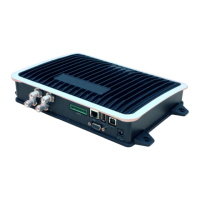4.2.
Timing
Considerations
In compliance with FCC Part 15 regulations, the reader never stays on one
frequency for more than 400 milliseconds. There are several mechanisms at
work to enforce the 400 ms cutoff. First, as the reader performs tag inventories,
from time to time it will check to see how much time is remaining from the 400
ms allotment for a given frequency. If there is less than 100 ms remaining, the
reader will hop to the next frequency.
Second, in some cases, if more than one antenna is in use, the reader will change
frequencies when an antenna change is performed; these antenna changes
typically occur many times within any 400 ms time period.
Finally, a hardware timer in the reader is dedicated to tracking the 400 ms dwell
time. Should a frequency continue to be used for 400 ms, because none of the
above conditions caused it to be changed, the timer will force a frequency
change at the 400 ms mark.
4.3.
Incorporation of Intelligence
FCC
Part
15.247(h)
The coordination of frequency hopping systems in any other manner for the
express purpose of avoiding the simultaneous occupancy of individual hopping
frequencies by multiple transmitters is not permitted.
By design and construction, the 1000 does not attempt to recognize other users
or interferers within this spectrum band for any type of coordination purposes.
In the statistically unlikely event that two readers with the same hopping
sequence become time-aligned in that sequence, there is sufficient signal
processing variation that occurs from reader-to-reader, especially when under
such interference conditions, and even more so when transponders are in the
field, that the alignment between the two will rapidly become less impactful/

